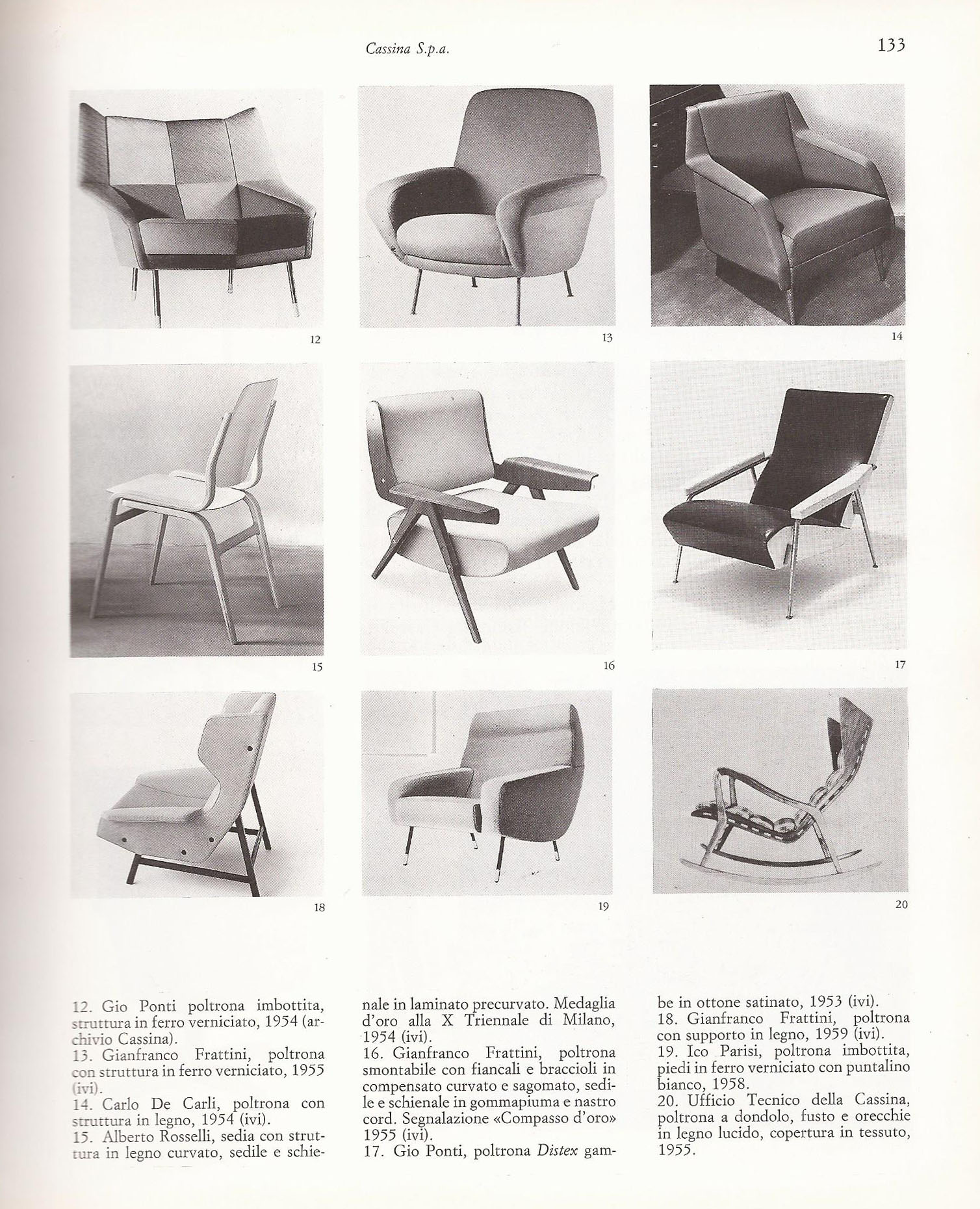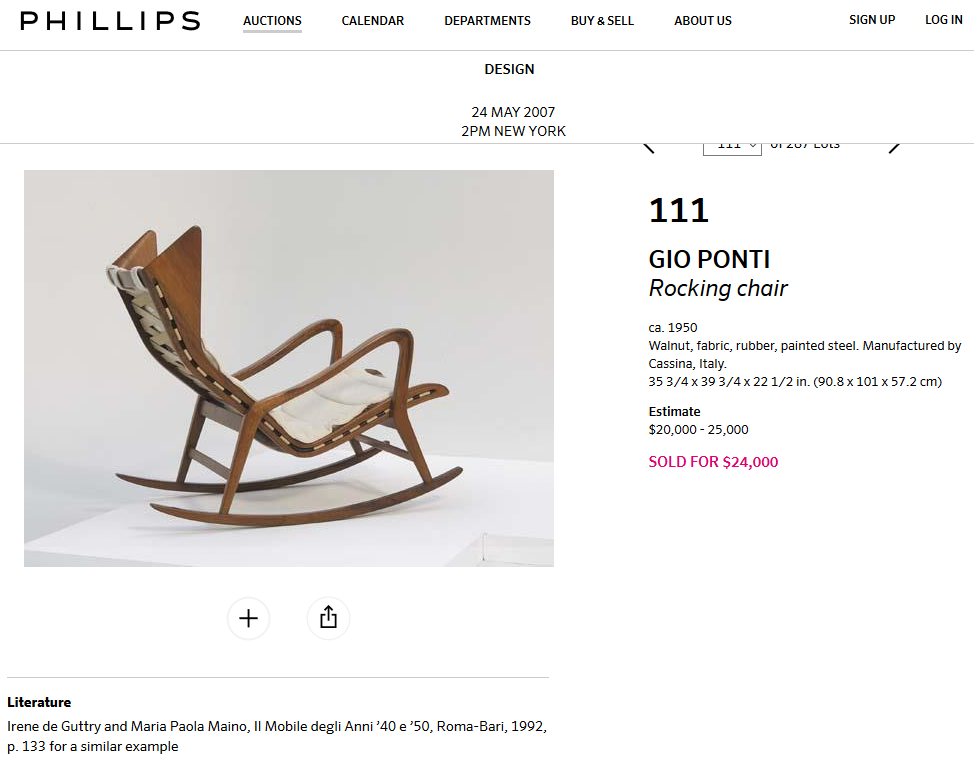
In September 2016, the PATROL received some information on lounge chairs sold for $13,000 at PIASA, on November 18th, 2015, from an anonymous informant. These chairs were advertised as “model 572”, edited by Cassina, and designed by Gio Ponti (Exhibit #1). True? False? The PATROL decided to investigate.

Exhibit #1
At first sight, it seems like PIASA’s experts are being coherent: they sold an identical lounge chair 7 months before for $13,000; same name, same editor, same designer, same book references & same value (Exhibit #2).

Exhibit #2
Both identifications do in fact come with references for justification (Exhibits #3&4). The bibliographical “label” has a huge impact on the value of design furniture… to a certain extent, until the PATROL pulls over auctioneers responsible of “manifest abuse of bibliographical references”. What about PIASA? Specialists or tourists?


Exhibit #3


Exhibit #4
The cited books are unmistakable, and give Gio Ponti absolutely no credit. In the contrary, the design is clearly by “Ufficio Tecnico della Cassina”, or in other words, it is a 100% homemade creation. PIASA the illusionist lives up to its reputation! If Gio Ponti did in fact work with Cassina, and more specifically on the most famous Superleggera chair starting 1957, he doesn’t seem to be this lounge chair’s designer.
Several theories may explain such a mistake from PIASA’s experts:
A/ They pulled Gio Ponti’s name out of their hat to enhance the chairs’ value
B/ They didn't double-check the book references and just copied/pasted their fellow experts' descriptions
C/ When money talks, ethic walks
Answer B seems to be the most accurate (and perhaps a bit of A & C as well!). Wanting 25% of the buyers’ expenses after “working” for 2 minutes is quite exciting after all. This kind of procedure is common in the design industry, as it occurred several times between 2001 and 2013 at WRIGHT, SOTHEBY’S (No! Really?!), CORNETTE de SAINT CYR... and many other Italian, Swiss and Americans auction houses (Exhibit #5). More surprising is that PHILLIPS and CHRISTIE’S also fell into the trap, when these two auction houses are usually on top of their game.






Exhibit #5
Among all the listed results, one of them catches the PATROL’s attention. The lounge chair was sold by an Italian auction house, which also quoted the exact same reference… and a “certificate from the Gio Ponti Archives” (Exhibit #6). Would our informant and the books be wrong, and the auctioneers right?!

Exhibit #6
The PATROL then contacts an Italian auctioneer, who replied with (way too rare) professionalism, and admitted the mistake made in its own catalog (Exhibit #7).

Exhibit #7
The investigators also contacted Gio Ponti’s Archives, who also confirmed the misattribution to Gio Ponti, and suggested a cohesive pattern with the help of book references (Exhibit #8): it might be a design by Cassina’s design office.

Exhibit #8
We feel released: our informant and the documentation are correct. What about PIASA & Co.? Well, they simply don’t have what it takes to be design experts.
After following Salvatore Licitra’s lead, the PATROL finally contacted Cassina’s historical headquarters in Meda, Italy. Five phone calls, four emails and two weeks later, the PATROL receives their answer, together with an extract of their 1964 catalog which closes the case for good (Exhibit #9).

"I confirm that this model was not design by Gio Ponti, but by Cassina's studios. Please find enclosed a catalog page from 1964".

Exhibit #9
Based on the PATROL’s experience, an artwork sold at auction and advertised with: a firmly identified designer + an editor’s name + matching literature + a model reference, is properly assigned to the legit maker. PIASA is the sad exception to the rule. Surprising? No, just disparaging! If the so-called design specialists at PIASA can make such mistakes on a 1964 design chair, the auctioneer's Medieval and Asian arts sales should make us cry!
Between our grasp on the informant’s tip and the resolution of the case, 30 days passed. PIASA could say that such investigations are impossible for them to run for every single one of their 300+ lots of each auction sale. “Wrong!” answers the PATROL, because this is the very reason why their clients pay them big money. If they don’t feel comfortable with it, they can still resign… and by looking at the way they run their business, it’s time for them to strongly rethink their career path.
Before closing this case, the PATROL would like to thank its informant for helping cleaning the market from the mistakes that infest it, and every single protagonist who helped solving the case.
Closed case.
 Book ’em! The auction house or the art dealer provided little or no corroborating evidence in the form of documentation for this item.
Book ’em! The auction house or the art dealer provided little or no corroborating evidence in the form of documentation for this item.
 Time Off! The expert made a significant mistake on this item. His attributed period came in way off. No early parole!
Time Off! The expert made a significant mistake on this item. His attributed period came in way off. No early parole!
 Missing persons alert! The auction house or the art dealer failed to uncover and identify the artist for this item.
Missing persons alert! The auction house or the art dealer failed to uncover and identify the artist for this item.
 Identity theft! They’re guilty of the worst crime of all: mislabeling the artist with another alias. And Picasso painted the Mona Lisa, right?!
Identity theft! They’re guilty of the worst crime of all: mislabeling the artist with another alias. And Picasso painted the Mona Lisa, right?!
The obsessive, nitpicky and no-holds-barred investigative team at DOCANTIC maintains an unparalleled database of original documentation for 20th Century, Art Nouveau, and Art Deco & Design furniture and works of art.
At DOCANTIC we believe that designers deserve proper identification for each work they have created, and that any art lover should confidently pay the right price for his or her purchase. We see the art world filled with both talented artists and con artist and, therefore, also riddled with innumerable attribution errors and outrageous pricing mistakes. By supplying authentic period photographs, DOCANTIC catches and apprehends the undervaluation (or overvaluation) of furniture and works of art. That’s our mission. We stop errors dead in their tracks. We serve and protect 20th Century furniture’s reputation.
Headquartered in Los Angeles, DOCANTIC sets the bar for the identification of 20th Century furniture, and shares with every art lover the information that has been kept under wraps by a handful of experts for far too long!